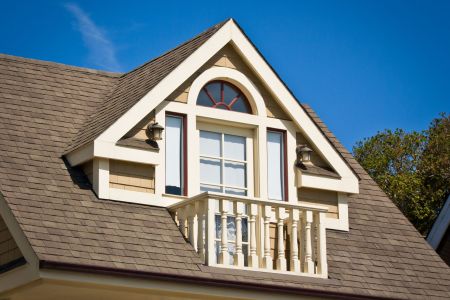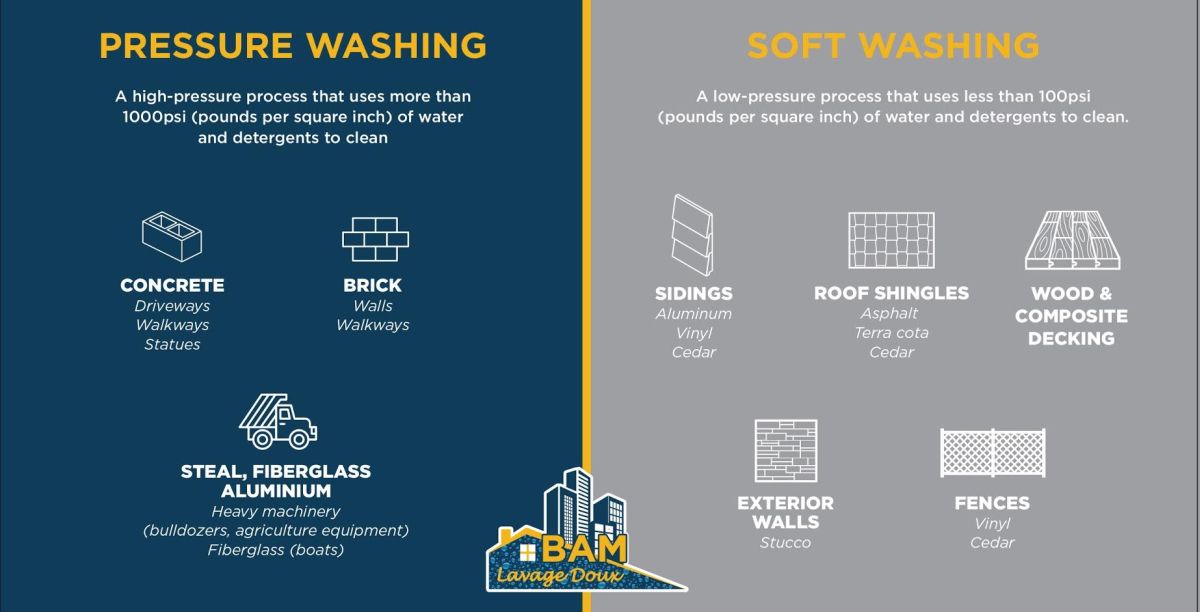HOW TO CLEAN ROOF SHINGLES

Let's look at the process of roof cleaning from the eyes of a trained professional, this may give you some insight on how you would go about to get all those black streaks or moss off your roof without harming it or anything on the ground. Afterall you don't want to clean your roof and kill plants.
LET'S DIAGNOSE THE SITUATION WITH THE ROOF
In most cases a professional will be able to tell what type of treatment would be required on the roof by doing a walk around the property. Identifying which sides of the roof need more love than the others to make sure it will be removed properly. It's important to have the right blend of products. When we get to a property, we usually encounter 2 types of algae, Gloeocapsa Magma which is black streaks. There is also Lichen, and sometimes we see moss, a plant based multicellular organism that arrive on the roof by spores from the wind and birds. They have a good environment to thrive by eating away the limestone from the roof shingles.
CAN YOU CLEAN YOUR ROOF WITH A PRESSURE WASHER?
Have you ever been close to the nozzle of a pressure washer wand? You can hear that pressure screaming out of that gun. Imagine what id does to the granules of the asphalt shingles. Worst off, all you would be doing is spreading around the algae and it would only continue to grow. Do you think if we can clean a roof with low pressure? Absolutely. It's much easier to apply the right quantity of detergents by using the same pressure as a garden hose, opening the nozzle to produce a fan spray that will coat the roof evenly. There is no way to harm any roof materials. This method is called soft washing.
PRESSURE WASHING VS SOFT WASHING

ROOF CLEANING USING BLEACH
You will not get rid of algae or moss on your roof without using a disinfecting agent. It will destroy the living organisms that have invaded the shingles. That being said, you need to be careful because it can damage any other landscaping on the ground. Don't chance your roof cleaning to someone who isn't well trained in the field. This is why you need to call on a professional, who understands the procedure of property management before commencing. A walk around the property is a must.
Does the home have gutters or not? If you have any, are they clear of debris to make sure they don't overflow onto sensitive plants? Where are they discharging the water accumulated from the roof? It's very important to know where the water flows past the gutter downspout. If there aren't any gutters, what's sitting along the ground of the shingle edges? The ground needs to be protected.
Let's talk about Sodium Hypochlorite 12.5% (pool shock). This is the algaecide used by pressure washing companies to clean roofs. Professionals purchase the liquid form in 50-gallon drums which is twice the strength of the regular "bleach" you buy from the local grocery store. There are different ratios we use, depending on the condition of every roof.
READY TO TACKLE YOUR ROOF?
You will need a pump-up sprayer in order to mix your water and Sodium Hypochlorite. Here are the different ratios:
- 50% Sodium Hypochlorite - 50% Water - Use this mix if there is algae and moss.
- 37.5% Sodium Hypochlorite - 62.5% Water - Use this mix for heavy black streaks (gloeocapsa magma).
- 25% Sodium Hypochlorite - 75% Water - Use this mix for very light black spots (gloeocapsa magma).
Now that you've determined the correct ratios make sure you're wearing your painting clothes, bleach will get on them, one way or another. Gloves will help to mix the solution in the pump-up sprayer, once that's done, you're almost ready to clean the roof. Have you located a safe place to stand up your ladder securely? Don't use rocks to stabilize it in the flower bed, you need a solid surface for the ladder. If you're unsure about getting on your roof or any other steps reach out to a professional. Don't take unnecessary risks.
HERE ARE THE STEPS TO CLEAN YOUR ROOF
- Prepare your roof mix as explained above. Make sure you're wearing protective gloves while mixing chemicals. Add a little laundry detergent or dish soap. This will help the chemical stick to the roof and stay wet longer in order to kill the algae.
- Get your garden hose out and start the pre soaking of all vegetation. Soak the root system as much as possible to ensure the plants are well saturated. This will help if some chemical lands on the foliage. If they're well saturated you risk less problems. You will need to repeat this process after the roof washing is done.
- Get on the well stabilized ladder and start spraying the roof from the top, a finer spray mist will be required to get to the higher point. Once you move lower, you can use a fan spray for a more even coating of the chemical.
- You will see the algae and moss turn white within 5 minutes. That's a good sign. The chemicals are working. If there are still some spots later you will need to spray again. Make sure it turns white, that's when you know its dead.
- Once you're done get that hose on and soak all the vegetation again. Don't be lazy and skip this process. You will regret not doing it soon after. There is always a little overspray when you treat the roof. By doing so you will avoid having to replace any plants.
- The chemical you sprayed will continue to work during the day. The potency will eventually dimmish and will not be dangerous if rain comes. Leave the roof alone and check back after a few weeks. The rain will help wash away any dead moss still lingering on the shingles. If some treatment is still required you can spot check again.
- Bookmark this page for easy reference to the procedure and mix ratios in the future.
DO IT YOURSELF OR HIRE A PROFESSIONAL
If your roof isn't very old and your shingles aren't curling, but you see black spots you now know that it's organic growth attacking the shingles. Roof washing will not only lengthen the life of your shingles, (which is a big investment when it comes time to replace them), they will also look like new again. You can decide to do it yourself by following the instructions above or you can call a professional team that has all the necessary training, equipment, and insurance to come in and take care of it properly. Once the algae are removed you shouldn't have any issues for 3 years and /or longer, depending where you're located. High trees and humidity are very favorable factors for algae growth.

